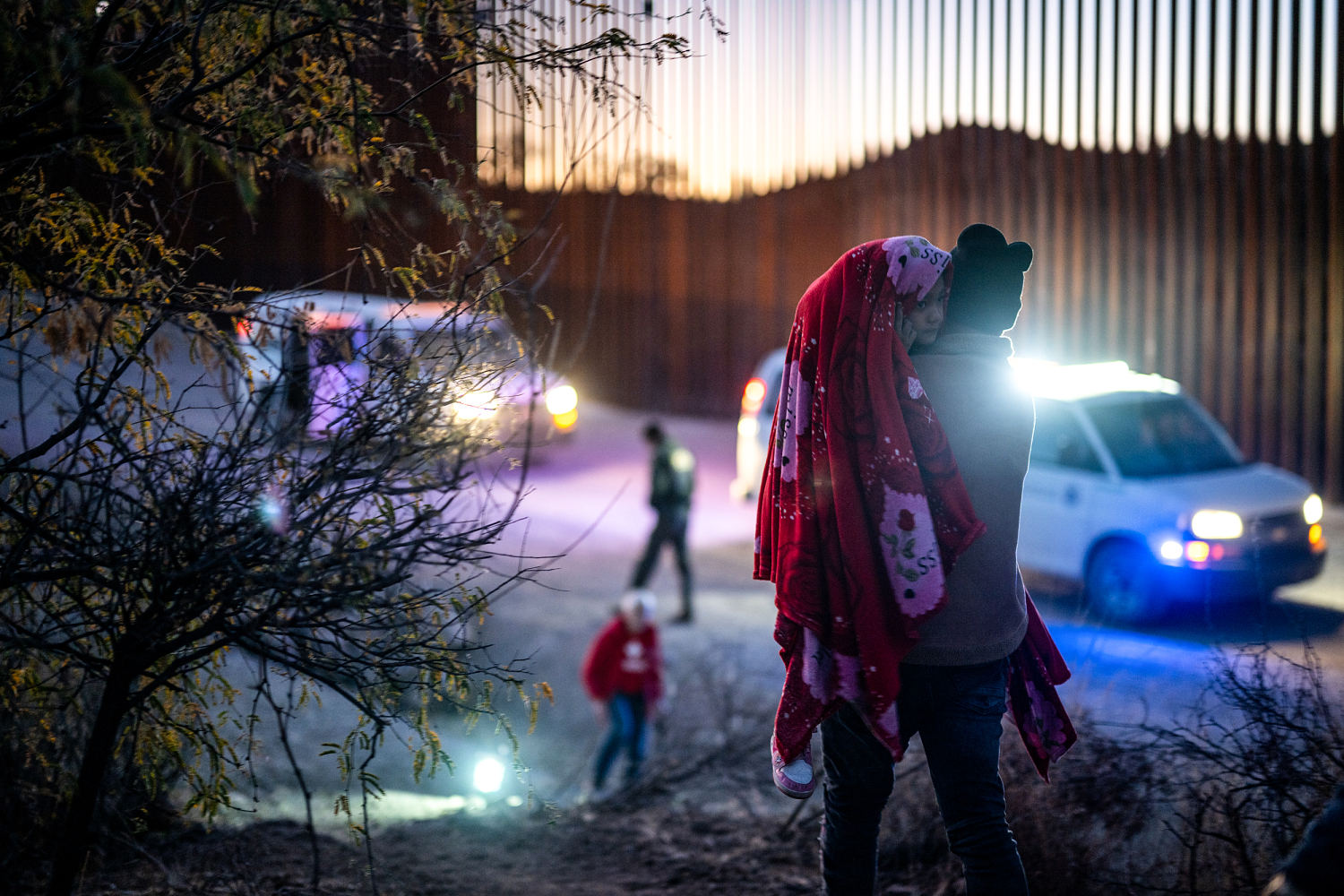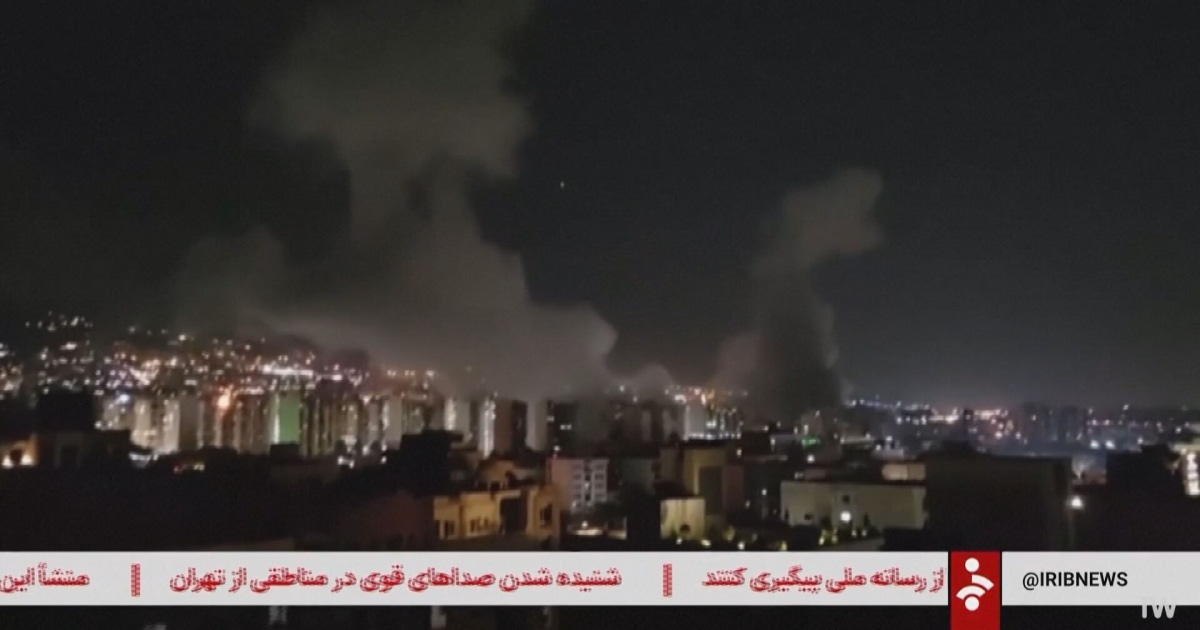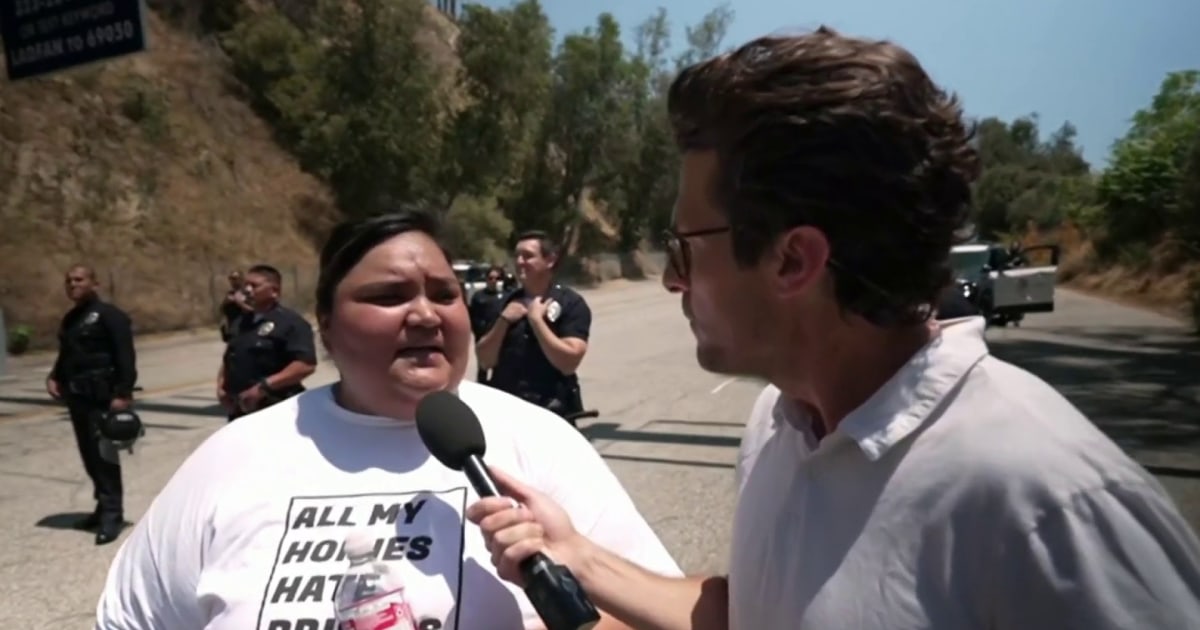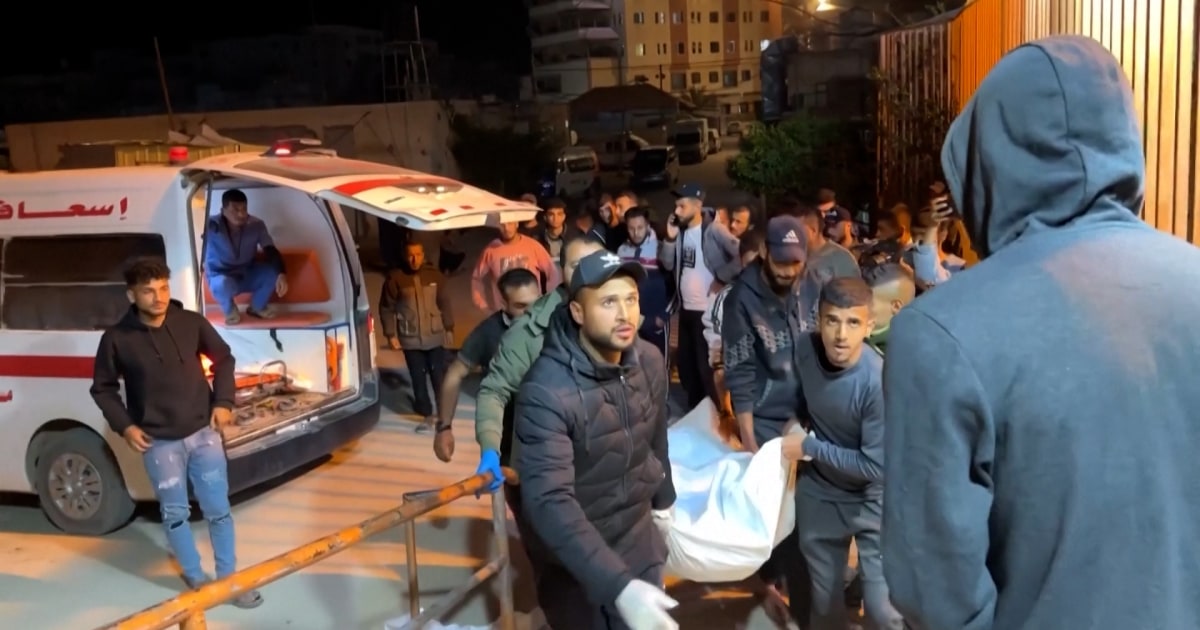
Despite a more than 90% drop in the number of migrant apprehensions at the border since President Donald Trump took office, people continue to try to reach the United States — and smugglers are taking them along more dangerous routes, according to authorities and groups assisting migrants.
In recent months, human smugglers have adopted another method to bring migrants into the country via the southern border: They are sending them alone through inhospitable terrain while guiding them remotely using cellphones, Jesus Vasavilbaso, a Border Patrol agent in Tucson, Arizona, told Noticias Telemundo.
An increasing number of people are being found by law enforcement in the desert without a “coyote,” or smuggler, he said. They’re dehydrated, dressed in camouflage and with pieces of carpet stuck to the soles of their shoes in an attempt to hide their tracks on the sand. The clothing is part of a crossing package that coyotes sell them, the Border Patrol agent said.
“If you don’t buy that kit, they won’t let you cross. It comes with camouflage, with those mats you put under your shoes, and a backpack with supplies, whether it’s water, IV drip, tortillas, or canned food. And that also includes your cellphone,” Vasavilbaso explained.
More closures — and more dangerous routes
Between February and April, 24,000 apprehensions were recorded along the southwest border, the majority in the El Paso and Rio Grande Valley sectors in Texas, the Arizona desert and the San Diego sector in California, according to federal data.
The nationalities of those crossing have shifted since the Biden administration, returning to the historical pattern led by Mexicans, given their geographic proximity. In April 2024 and 2023, migrants from Mexico accounted for one-third of all apprehensions; in April this year they accounted for 73%.
“We’re seeing Mexicans, Guatemalans, Hondurans and occasionally people who aren’t from the (American) continent. The majority we’re encountering now are unaccompanied adults. Very rarely do we see a family. And we have seen two or three unaccompanied children,” Vasavilbaso said.
Crossing through the desert and mountains is in itself very dangerous, and with the increased border security — Trump sent 1,500 additional troops to build barriers, and the Mexican government, under threat of tariffs, reinforced border patrols with 10,000 members of the National Guard — smugglers are turning to more remote and risky routes to try to evade federal controls.
“They are no longer crossing through places where they typically crossed (…) right now we are seeing that people are crossing through a very difficult mountain,” Pedro Ríos, director of the border program for the American Friends Service Committee in San Diego, California, told Noticias Telemundo.
Ríos is referring to Otay Mountain in eastern San Diego County, a difficult-to-access wilderness area with rocky passes and extreme conditions. On Feb. 14, in two separate incidents, three migrant border crossers — a woman and two adult men — died on the mountain during a storm where temperatures “dropped to near-freezing levels,” according to the Border Patrol.
Separately, agents responding to an emergency call found a 16-year-old girl suffering from hypothermia, without food or water, and two deceased adults. One of them was her father.
On March 28, two Mexican women, one of them pregnant, were rescued from a remote canyon in Otay Mountain; they were unable to walk due to ankle injuries and they lacked food or water. Agents set up a makeshift tent for protection from the elements until they were evacuated by helicopter the following morning.
“As we start seeing more closures of traditional crossing points, the crossings become much more dangerous,” Ríos said.
In Arizona, coyotes have returned to dangerous routes in the Sonoran Desert in areas such as the Cabeza Prieta National Wildlife Refuge, the Tohono O’odham Indian Territory, the Baboquivari Mountains and around Sasabe, a remote village less than a mile from the border in Pima County, Vasavilbaso said.
“When a person crosses that town, they have to walk approximately 45 miles to reach the next paved road. So, although it’s not mountainous, it’s very dangerous because it will take them two to three days to get there, and they can’t carry enough water and food,” he said.
In the summer, temperatures in the Sonoran Desert frequently exceed 104°F and sometimes reach 118°F, according to the National Park Service.
In 2024, rescuers and authorities found the remains of 154 migrants in the Arizona desert, according to data from the Pima County Medical Examiner’s Office and Humane Borders, which maintains a system of water stations for migrants in the Sonoran Desert.
The remains were mostly discovered in the Cabeza Prieta Wilderness Area, in the low desert, and in the Tohono O’odham Indigenous Territory.
So far in 2025, the remains of 40 migrants have been found in Arizona. Because of the condition they were in — in many cases, skeletons — it’s presumed that most of the remains belong to people who crossed months or years ago, Professor Brad Jones, director of Humane Borders, told Noticias Telemundo.
And while the flow of migrants along the more familiar routes south of Tucson have plummeted, Jones predicts the flow will shift to the western side of the Sonoran Desert, which is “even more remote.”
“It’s a part of the desert where humanitarian groups are simply forbidden to go. And by that, I mean, a lot of the land on the Arizona-Mexico border in far western Arizona is U.S. military,” Jones said.
The deadly consequences of this shift in migration routes will become clearer over time, Jones said.
“Migrants come, they just take greater risks. And I suspect that in the coming weeks and months, we’re going to start seeing more remains recovered in the more remote areas of Arizona,” he said.
César Ortigoza, founder of the Armadillos group, a nongovernmental organization that searches for missing people along the border, warned that the Arizona military zone is one of the most dangerous for migrants.
The Barry M. Goldwater Air Force Range is located there. It’s an active bombing range where Ortigoza and his group once found the remains of 12 migrants, including fragmented remains that led them to believe that at least one person died from a bomb blast.
Ortigoza said the routes migrants are traveling through the desert require between six and 10 days to reach a highway, where smugglers are waiting.
It’s very difficult for them to survive all that time walking, because they have to carry a lot of water. We believe the most they could carry is eight gallons of water, which they’ll run out of in two or three days,” Ortigoza said in an interview in Mexico City.
On May 21, border agents intercepted a coyote in a remote area near Lukeville, Arizona, walking through the desert with four migrants who had crossed the border that morning: a 49-year-old Cuban woman and a 27-year-old woman from Uzbekistan, accompanied by two young children.
“Smuggling through remote desert areas poses significant danger, particularly for families with children,” Sean McGoffin, chief Border Patrol agent in the Tucson sector, said in a statement about the case.
A new strategy: remote coordination
The use of technology is changing the way smugglers operate, as they now prefer to send migrants on their own and guide them remotely through the desert. “Criminal organizations are selling them cellphones. They’re directing people through cellphones, giving them coordinates via WhatsApp or telling them to dial a number and then giving them directions,” Vasavilbaso said.
“When I started as a Border Patrol agent 16 years ago, we always saw people regularly crossing with a coyote. Now that many people carry cellphones, they’re being left to their own devices. The danger of this is that they don’t know the terrain, so they have to count on having a cellphone signal to be able to make that call and also be able to understand the instructions the coyotes are giving them,” he said.
On Feb. 27, agents detained three migrants who had crossed the border without permission at a ranch near Carrizo Springs, Texas. They were wearing rugs on their shoe soles, which is a new practice among smugglers, Vasavilbaso explained. Smugglers attach pieces of carpet to the migrants’ shoe soles so they don’t leave traces in the desert that border agents can follow.
“I’m not going to lie to you. It’s a little more difficult when they bring those carpets,” though he said it wasn’t impossible to follow. Nevertheless, this tactic is also “a double-edged sword,” according to Vasavilbaso, because when migrants end up lost and call emergency services for help, it becomes more difficult to locate them because there’s no trail for agents to follow.
“It’s a little late for us to be able to provide them with the help they need,” he said.
Vasavilbaso blamed criminal groups for the danger migrants face when traveling along these inhospitable border routes: “If they cross through a more dangerous area, it’s because coyotes are taking them through those places. Those people didn’t choose to cross there.”
A lucrative business that persists
The desert isn’t the only death trap for migrants who continue to cross illegally. The presence of authorities at highways and border cities has led smugglers to make risky decisions and abandon migrants to their fate regardless of the conditions, authorities say.
On March 28, two migrants from Guatemala, including a 14-year-old boy, drowned near Elsa, Texas, after the smuggler transporting them in a pickup truck drove into a canal while being pursued by authorities. The victims had crossed the Rio Grande River with a group of 11 others earlier that morning. The mother of the deceased boy, Juana Veronica Macario-Chan, who was also in the vehicle, told authorities she had agreed to pay $16,000 to be taken with her two children to Los Angeles, California, according to court documents.
Despite the restrictions imposed by the Trump administration, human smuggling remains a lucrative business for criminal organizations, which continue to charge for transporting people to U.S. territory or simply for permission to cross the border, Vasavilbaso said.
“Criminal organizations control the border on the Mexican side, and no one crosses without their permission,” he added.
On May 9, following a chase along the highways of Laredo, Texas, Border Patrol agents apprehended four Mexican migrants who had crossed the river as well as the coyote who had loaded them into a vehicle. One of the migrants, Omar Osiel Ruiz Gómez, told border agents he had paid $7,000 to cross and travel to Houston. The four migrants were taken into Border Patrol custody. The coyote who transported them, Humberto García, faces charges of bringing and transporting undocumented migrants to the United States. He has pleaded not guilty, according to court documents.
On May 22, agents arrested three more migrants — two Mexicans and one Honduran — who crossed the Rio Grande River in McAllen. One of them admitted to paying $2,500 for permission to cross. All three wore bracelets indicating payment to the cartel, said Lt. Chris Olivarez, a spokesperson for the Texas Department of Public Safety.
In another case, a 15-year-old boy from Reynosa, Mexico, who was arrested on May 21 in Hidalgo County, Texas, while guiding a group of migrants across the river, told police that the organization that recruited him paid him $150 for each person he managed to cross. He also explained that criminal groups use geographic coordinates and encrypted messages to coordinate trips.
The young man faces charges of human smuggling and is being held at a local juvenile detention center awaiting a judge’s decision on his case, Lieutenant Olivarez told Noticias Telemundo.
Despite increased border security and the Trump administration’s restrictive immigration policies, Vasavilbaso acknowledged it’s “impossible” to stop the crossing of undocumented immigrants across the southern border of the United States.
“Ever since man existed, there have been people who migrate. Humans will always look for a way to find a better life — I think it’s impossible to stop it, but we can have a controlled way of how people migrate,” he said.
He also issued a warning to those considering crossing the border without papers. “Don’t take the risk, as it’s dangerous, and the possibility of being detected, detained, and returned to your country is higher than ever.”
An earlier version of this story was first published in Noticias Telemundo.








